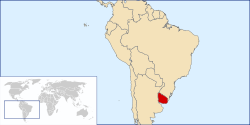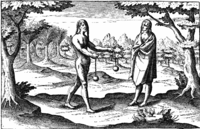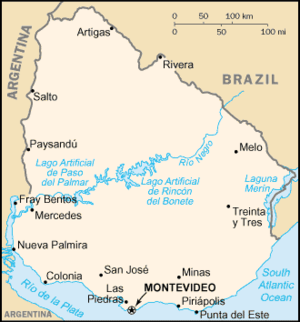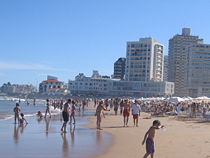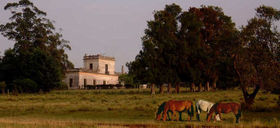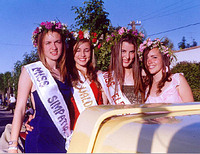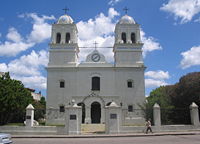Uruguay
2008/9 Schools Wikipedia Selection. Related subjects: Americas; Countries
| República Oriental del Uruguay (Spanish) Eastern Republic of Uruguay
|
||||||
|---|---|---|---|---|---|---|
|
||||||
| Motto: Libertad o muerte (Spanish) "Freedom or death" |
||||||
| Anthem: Himno Nacional Uruguayo (Spanish) |
||||||
|
|
||||||
| Capital (and largest city) |
Montevideo |
|||||
| Official languages | Spanish | |||||
| Demonym | Uruguayan, Oriental | |||||
| Government | Republic ( presidential system) | |||||
| - | President | Tabaré Vázquez Rosas | ||||
| - | Vice President | Rodolfo Nin Novoa | ||||
| Independence | from Brazil | |||||
| - | Declaration | 25 August 1825 | ||||
| - | Constitution Jury | 18 July 1830 | ||||
| Area | ||||||
| - | Total | 176.215 km² 68,037 sq mi |
||||
| - | Water (%) | 1.5% | ||||
| Population | ||||||
| - | July 2008 estimate | 3,477,778 ( 134) | ||||
| - | 2002 census | 3,399,236 | ||||
| - | Density | 19/km² ( 19) 50/sq mi |
||||
| GDP ( PPP) | 2006 estimate | |||||
| - | Total | $37,18 billion (USD) | ||||
| - | Per capita | $11,621(USD) | ||||
| Gini (2003) | 44.9 (high) | |||||
| HDI (2007) | ▲ 0.852 (high) ( 46th) | |||||
| Currency | Uruguayan peso ($, UYU ) ( UYU) |
|||||
| Time zone | UYT ( UTC-3) | |||||
| - | Summer ( DST) | UYST ( UTC-2) | ||||
| Internet TLD | .uy | |||||
| Calling code | +598 | |||||
Uruguay (official full name in Spanish: República Oriental del Uruguay; Spanish pronunciation: [reˈpuβlika oɾjenˈtal ðel uɾuˈɣwai], Eastern Republic of Uruguay) is a country located in the southeastern part of South America. It is home to 3.46 million people, of which 1.7 million live in the capital Montevideo and its metropolitan area.
It is bordered by Brazil to the north, by Argentina across the bank of both the Uruguay River to the west and the estuary of Río de la Plata to the southwest, and the South Atlantic Ocean to the southeast. Its surface is 176.215 km² being by its territorial extension the second smallest country in South America, larger only than Suriname and the French overseas department of French Guiana.
Montevideo was founded by the Spanish in the early 18th century as a military stronghold. Uruguay won its independence in 1825-1828 following a three-way struggle between Spain, Argentina and Brazil. It is a constitutional democracy, where the president fulfills the roles of both head of state and head of government.
The economy is largely based on agriculture (making up 10% of GDP and the most substantial export) and the state sector, Uruguay's economy is on the whole more stable than in its surrounding states, and it maintains a solid reputation with investors.
According to Transparency International, Uruguay is the second least corrupt country in Latin America (after Chile), with its political and labor conditions being among the freest on the continent.
In November 2007 it became the first Latin American country and the second in all of the Americas to recognize same-sex civil unions at the national level.
94.6% of the population are of European descent. Just under half of the population are declared Roman Catholics. However, the majority of Uruguayans are only nominally religious.
Etymology
The name "Uruguay" comes from Guaraní. It has many possible meanings. Some of the proposed meanings are:
- "River of the uru" or "River of the country of the uru": a version attributed to Felix de Azara, which suggests that the name of the country comes from the word urú, which means "bird" in the vicinity of the Uruguay River (from uru = "bird", gua = "place of", and y = "water").
- "River of colorful or 'painted' chinchillas (birds)": poetic interpretation attributed to Juan Zorrilla de San Martín.
- "River of those who bring food": an anonymous version which has been popularized since the discovery of an old document written by Jesuit Lucas Marton.
History
The inhabitants of Uruguay before European colonization of the area were various tribes of hunter gatherer native Americans, the most well known being the Charrúa Indians, a small tribe driven south by the Guaraní Indians of Paraguay. The population is estimated at no more than 5,000 to 10,000.
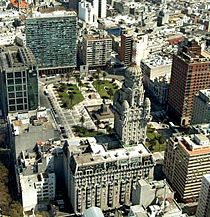
Europeans arrived in the territory of present-day Uruguay in the year 1536, but the absence of gold and silver limited settlement in the region during the 16th and 17th centuries. Uruguay became a zone of contention between the Spanish and the Portuguese empires. In 1603 the Spanish began to introduce cattle, which became a source of wealth in the region. The first permanent settlement on the territory of present-day Uruguay was founded by the Spanish in 1624 at Villa Soriano on the south-western coast of the Río Negro. In 1680 the Portuguese built a fort at Colonia del Sacramento. Spanish colonization increased as Spain sought to limit Portugal's expansion of Brazil's frontiers.
Another segment of colonial Uruguay's population consisted of people of African descent. Colonial Uruguay's African community grew in number as its members escaped harsh treatment in Buenos Aires. Many relocated to Montevideo, which had a larger black community, seemed lest hostile politically than Buenos Aires, and had a more favorable climate with lower humidity.
As a province of the Viceroyalty of La Plata, colonial Uruguay was known as the Banda Oriental, or "Eastern Strip", referring to its location east of the Rio Uruguay. The inhabitants called themselves Orientales ("Easterners"), a term they still commonly use to refer to themselves.
Uruguay's capital, Montevideo, was founded by the Spanish in the early 18th century as a military stronghold; its natural harbor soon developed into a commercial centre competing with Argentina's capital, Buenos Aires. Uruguay's early 19th century history was shaped by ongoing conflicts between the British, Spanish, Portuguese, and colonial forces for dominance in the Argentina-Brazil-Uruguay region. In 1806 and 1807, the British army attempted to seize Buenos Aires as part of their War with Spain. As a result, at the beginning of 1807, Montevideo was occupied by a 10,000-strong British force who held it until the middle of the year when they left to attack Buenos Aires.
The Uruguayans' road to independence was much longer than those of other countries in the Americas. Early efforts at attaining independence focused on overthrow of Spanish rule, a process begun by Jose Gervasio Artigas in 1811 when he led his forces to victory against the Spanish in the battle of Las Piedras on May 18, 1811. In 1816, Portuguese troops invaded present-day Uruguay, which led to its eventual annexation by Brazil in 1821 under the provincial name, Provincia Cisplatina. On April 19, 1825, thirty-three Uruguayan exiles led by Juan Antonio Lavalleja returned from Buenos Aires to lead an insurrection in Uruguay with the help of Argentine troops. They were known as the Treinta y Tres Orientales. Their actions inspired representatives from Uruguay to meet in Florida, a town in the recently liberated area, where they declared independence from Portugal (and therefore Brazil) on August 25, 1825. Uruguayan independence was not recognized by its neighbors until 1828, after the Argentina-Brazil War, when Britain, in search of new commercial markets, brokered peace between Argentina, Brazil, and Uruguay.
Politics
Uruguay's politics take place in a framework of a presidential representative democratic republic, whereby the President of Uruguay is both head of state and head of government, and of a multi-party system. Executive branch is exercised by the government. Legislative branch is vested in both the government and the two chambers of the General Assembly of Uruguay. The Judiciary is independent of the executive and the legislature.
For most of Uruguay's history, the Partido Colorado has been the government. The other "traditional" party of Uruguay, Partido Blanco, having ruled only twice. The Partido Blanco has its roots in the countryside and the original settlers of Spanish origin and the cattle ranchers. The Partido Colorado has its roots in the port city of Montevideo, the new immigrants of Italian origin and the backing of foreign interests. The Partido Colorado built a welfare state financed by taxing the cattle revenue and giving state pickles and free services to the new urban immigrants which became dependent on the state. The elections of 2004, however, brought the Frente Amplio, a coalition of socialists, former Tupamaros, former communists and mainly social democrats among others to govern with majorities in both houses of parliament and the election of President Tabaré Vázquez by an absolute majority.
The Reporters Without Borders worldwide press freedom index has ranked Uruguay as 57th of 168 reported countries in 2006.
According to Freedom House, an American organization that tracks global trends in political freedom, Uruguay ranked twenty-seventh in its " Freedom in the World" index. According to the Economist Intelligence Unit, Uruguay scores a 7.96 on the Democracy Index, located in the last position among the 28 countries considered to be Full Democracies in the world. The report looks at 60 indicators across five categories: Free elections, civil liberties, functioning government, political participation and political culture.
Uruguay ranks 28th in the World CPI (Corruption Perception Index) composed by Transparency International.
Culture
Uruguay has an impressive legacy of artistic and literary traditions, especially for its small size. The contribution of its alternating conquerors and diverse immigrants has resulted in native traditions that integrate this diversity. Uruguay has centuries old remains, fortresses of the colonial era. Its cities have a rich architectural heritage and an impressive number of writers, artists, and musicians. Uruguayan tango is the form of dance that originated in the neighborhoods of Montevideo, Uruguay towards the end of the 1800s. Tango, candombe, and murga are the three main styles of music in this city.
Direct democracy
The Uruguayan constitution allows citizens to repeal laws or to change the constitution, by referendum. During the last 15 years the method has been used several times; to confirm a law renouncing prosecution of members of the military who violated human rights during the military regime (1973-1985), to stop privatization of public utilities companies (See Economy: Public Sector), to defend pensioners' incomes, and to protect water resources.
Departments
Uruguay consists of nineteen departments (departamentos, singular "departamento"). The first departments were formed in 1816 and the newest date from 1885 which is Flores. The departments are governed by an intendente municipal who is elected for five years. The members of the Departmental Assembly (Junta Departamental) form the legislative level of the department.
| Department | Area (square kilometres) | Population* | Capital |
|---|---|---|---|
| Artigas | 11,928 | 78,019 | Artigas |
| Canelones | 4,536 | 485,028 | Canelones |
| Cerro Largo | 13,648 | 86,564 | Melo |
| Colonia | 6,106 | 119,266 | Colonia del Sacramento |
| Durazno | 11,643 | 58,859 | Durazno |
| Flores | 5,144 | 25,104 | Trinidad |
| Florida | 10,417 | 68,181 | Florida |
| Lavalleja | 10,016 | 60,925 | Minas |
| Maldonado | 4,793 | 140,192 | Maldonado |
| Montevideo | 530 | 1,326,064 | Montevideo |
| Paysandú | 13,922 | 113,244 | Paysandú |
| Río Negro | 9,282 | 53,989 | Fray Bentos |
| Rivera | 9,370 | 104,921 | Rivera |
| Rocha | 10,551 | 69,937 | Rocha |
| Salto | 14,163 | 123,120 | Salto |
| San José | 4,992 | 103,104 | San José de Mayo |
| Soriano | 9,008 | 84,563 | Mercedes |
| Tacuarembó | 15,438 | 90,489 | Tacuarembó |
| Treinta y Tres | 9,676 | 49,318 | Treinta y Tres |
| * 2004 | |||
Geography
At 176,214 square kilometres (68,036 square miles) of continental land and 142,199 square kilometres (54,903 sq mi) of jurisdictional waters and small river islands, Uruguay is the second smallest sovereign nation in South America (after Suriname) and the third smallest territory (French Guiana is the smallest). The landscape features mostly rolling plains and low hill ranges (cuchillas) with a fertile coastal lowland. A dense fluvial network covers the country, consisting of four river basins or deltas; the Río de la Plata, the Uruguay River, the Laguna Merín and the Río Negro. The major internal river is the Río Negro ('black river'). Several lagoons are found along the Atlantic coast.
The highest point in the country is the Cerro Catedral at 513.66 meters (1,685 ft 3 in) in the Sierra de Carapé mountain range. To the southwest is the Río de la Plata, the estuary of the Uruguay River, which forms the western border, and the Paraná River, that does not run through Uruguay itself.
Borders
Uruguay shares borders with Argentina and Brazil.
With Argentina:
- Uruguay River to the west and Río de la Plata in the south.
With Brazil:
- Chuy Stream 13 kilometres (8.1 mi), straight line (Chuy) 8.7 kilometres (5.4 mi), San Miguel Stream 13 km (8.1 mi), Merín Lagoon, 280.1 km (174 mi) Yaguarón River, 142.4 km (88.5 mi), Yaguarón 'Chico' River 18.5 km (11.5 mi), 'Arrollo de la Mina' Stream 20.4 km (12.7 mi), Aceguá straight line 37.2 km (23.1 mi), San Luis Stream 31.3 km (19.4 mi), North Branch of the San Luis Stream 3.6 km (2.2 mi), Straight line 8 km (5 mi), 'Cañada del Cementerio' 4 km (2.5 mi), Straight lines 0.6 km (0.4 mi), 'Cuchilla de Santa Ana' SE 168.5 km (104.7 mi), Rivera-Livramento 4.8 km (3 mi), 'Cuchilla de Santa Ana' 20.8 km (12.9 mi), 'Cuchilla Negra' 4189.3 km (2603.1 mi), 'Arrollo de la Invernada' Stream 37.8 km (23.5 mi), Cuareim River 313.4 km (194.7 mi)
Climate
The climate in Uruguay is temperate: it has warm summers and cold winters. The predominantly gently undulating landscape is also somewhat vulnerable to rapid changes from weather fronts. It receives the periodic influence of the polar air in winter, and tropical air from Brazil in summer. Without mountains in zone that act as a barrier, the air masses freely move by the territory, causing abrupt weather changes.
The coolest month is June, while the warmest is January. The rainfall is equally distributed throughout the year, but tends to be a bit more frequent in the autumn months. There can be frequent thunderstorms in the summer. Although snow is not very common, it snowed in 1913, 1918, 1963, 1989, 1992, and 2007.
Enclaves and exclaves
Since 1984 Uruguay has the Antarctic base "General Artigas" on King George Island in Antarctica, part of the South Shetland Islands archipelago, at , some 100 km (62 mi) from the Antarctic peninsula itself.
Economy
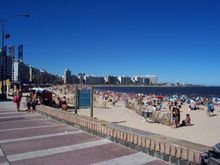
Uruguay has a middle income economy, mainly dominated by the State services sector, an export-oriented agricultural sector and an industrial sector. Uruguay relies heavily on trade, particularly in agricultural exports, leaving the country particularly vulnerable to slumps in commodity prices and global economic slowdowns. After averaging growth of 5% annually in 1996-1998, in 1999-2001 the economy suffered from lower demand in Argentina and Brazil, which together account for nearly half of Uruguay's exports. Despite the severity of the trade shocks, Uruguay's financial indicators remained stabler than those of its neighbours, a reflection of its solid reputation among investors and its investment-grade sovereign bond rating — one of only two in South America. In recent years Uruguay has shifted some of its energy into developing the commercial use of technologies and has become the first exporter of software in Latin America.
While some parts of the economy appeared to be resilient, the downturn had severe impact on the local population. Unemployment levels rose to more than 20%, real wages fell, the peso devalued. These worsening economic conditions played a part in turning public opinion against the mildly free market economic policies adopted by the previous administrations in the 1990s, leading to the popular rejection of proposals for privatization of the state petroleum company in 2003 and of the state water company in 2004. The newly elected Frente Amplio government, while pledging to continue payments on Uruguay's external debt, has also promised to undertake a Emergency Plan (See section:Social Problems Poverty and inequality) to attack the widespread problems of poverty and unemployment.
Agriculture
Agriculture played such an important part in Uruguayan history and national identity until the middle of the twentieth century that the entire country was then sometimes likened to a single huge estancia (agricultural estate) centred around Montevideo, where the wealth generated in the hinterland was spent, at its casco or administrative head.
Today, agriculture contributes roughly 11% to the country’s GDP and is still the main foreign exchange earner, putting Uruguay in line with other agricultural exporters like Brazil, Canada and New Zealand. Uruguay is a member of the Cairns Group of exporters of agricultural products. Uruguay’s agriculture has relatively low inputs of labor, technology and capital in comparison with other such countries, which results in comparatively lower yields per hectare but also opens the door for Uruguay to market its products as "natural" or "ecological."
Campaigns like “Uruguayan grass-fed beef” and “Uruguay Natural” aim to establish Uruguay as a premium brand in beef, wine and other food products.
Recently, an industry has developed around estancia tourism which capitalizes on the traditional or folkloristic connotations associated with gaucho culture and the remaining resources of Uruguay's historic estancias.
Demographics
The overwhelming majority of Uruguay's population is of predominantly white European descent: Spaniards, and Italians being the most prevalent, followed by French, Germans, Portuguese, British, Swiss, Russians, Poles, Bulgarians, Hungarians, Ukrainians, Lithuanians, Estonians, Latvians, Lebanese, Israeli, Dutch, Belgians, Croatians, Austrians, Serbians, Greeks, Scandinavians, Irish, Romanians, and Armenians. There are also numbers of Argentines, Chileans, Paraguayans, Brazilians, Bolivians, Israeli, and Lebanese. According to the 2006 National Survey of Homes by the Uruguayan National Institute of Statistics: 94.6% chose European ancestry, 9.1% chose Afro/Black ancestry, and 4.5% chose native-American ancestry (people surveyed were allowed to choose more than one option).
Many of the European immigrants arrived in Uruguay in the late 1800s and have heavily influenced the architecture and culture of Montevideo and other major cities. For this reason, Montevideo and life within the city are reminiscent of parts of Europe.
Some colonies such as Colonia Valdense -a Waldensian colony-, Colonia Suiza -also named Nueva Helvecia- a mainly Swiss colony with some German and Austrian settlers, were founded in the department of Colonia. There are also towns founded by early British settlers such as Conchillas and Barker. A Russian colony called San Javier was founded in the department of Río Negro. Mennonite colonies can also be found in the department of Río Negro and in the department of Canelones. One of them, called El Ombú, is famous for its well-known Dulce de Leche "Claldy" and is located near the city of Young.
Uruguay has a large urban middle class and a literacy rate of 96.79% (1996 est). During the 1970s and 1980s, an estimated 600,000 Uruguayans emigrated, mainly to Spain, Italy, Argentina and Brazil. Other Uruguayans went to various countries in Europe, to the USA, Canada, and Australia.
Religion
Church and state are officially separated since 1919. According to the 2006 National Survey of Homes by the Uruguayan National Institute of Statistics: 47.1% of Uruguayans define themselves as Roman Catholic, 23.2% as "believing in God but without religion", 17.2% as Atheist or Agnostic, 11.1% "Non-Catholic Christian" ( Protestant), 0.6% as followers of Umbanda or other "afro" religions, 0.3% as Jewish, and 0.4% chose "Other".
The majority of Uruguayans do not actively practice religion. It is widely considered the most secular nation in Latin America.
Social Issues
According to data published by the United Nations, the Gini index for Uruguay was 0.449 in 2003, where 1.00 stands for maximum inequality and 0 for even distribution of the wealth between the population.
A recent report used 2 indicators to estimate the number of people living in poverty in the country.
- Indigence line: income of the family is not enough for the basic food consumption.
- Poverty line: income of the family is not enough for food consumption, clothing, health and transport.
The numbers obtained depends according with the methodology used, the inform uses 3 different methods. According to the one proposed by the Regional Workshop about poverty measurement in 1996, which produces the highest values of all, the results for the first quarter of 2006 are:
Population below Indigence line: 3.01%
Population below Poverty line: 18%
The reports shows the indicators are improving as the country is recovering from the last 2002 crisis; in 2004, poverty indicators reached an all time high.
A new ministry of Social Development was created by the Broad Front (Uruguay) (Frente Amplio) government led by Tabare Vazquez, and an Emergency plan which targets the less favoured 200.000 Uruguayans.
The average income of a woman in 2002 in Uruguay was 71.8% of the income of men for the same activity. The average income of African heritage workers is 65% of that of those of European heritage.
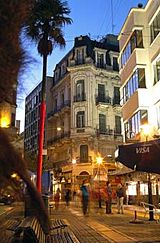
Although rents in neighborhoods not in high demand are not very expensive in Uruguay, it is usually required to have another property as a warranty for the contract, or leave a deposit which many can not afford. This first condition makes renting a property especially difficult for the least favoured sectors of the population. According to the INE 23, 3% of the population lives in a place neither owned nor rented. Some of them are proper built houses, but others are precarious constructions built illegally in public or private empty land just outside the cities. Thus, whole new poor neighborhoods have emerged in the last decades. They are called Asentamientos or more colloquially Cantegriles in ironic allusion to the fashionable Neighbourhood of Cantegril in Punta del Este. The phenomena is similar to the Favelas in Brazil, Villas Miseria in Argentina, Barrios in Venezuela, Arrabales in Spain, Poblaciones Callampa in Chile or Jacales in Mexico.
Sport
The main sport in Uruguay is football. The Uruguay national football team is one of only five nations to win the FIFA World Cup on two or more occasions. In 1930, Uruguay hosted the first ever World Cup and went on to win the competition, defeating Argentina 4-2 in the final. Uruguay won the 1950 FIFA World Cup as well, famously defeating the favored hosts, Brazil, 2-1 in the final. Uruguay is by far the smallest country, population wise, to win a World Cup. Out of the World Cup winners, the nation with the second smallest population is Argentina (winners of the 1978 and 1986 editions) who currently have just over 40,000,000 people according to the latest estimate; the 2002 census has Uruguay's current population slightly under 3,400,000. The Uruguay national team has also won the Copa América 14 different times, a record it shares with Argentina.
The most popular football teams in Uruguay are Club Nacional de Football (Three times World champions, three times Copa Libetadores de América champions, two times Copa Interamericana champions, one time Recopa Sudamericana champions) and Club Atlético Peñarol (Three times World champions, five times Copa Libertadores de América champions), followed by Defensor, Danubio (last Uruguayan champion). Uruguay has had many great known players such as Enzo Francescoli and Currently known now Alvaro Recoba and Diego Forlan (UEFA golden boot winner).
Basketball, Rugby, and tennis are other popular sports in Uruguay.
Brother countries
New Zealand Minnesota (Partner for the Americas)
International rankings
- Political and economic rankings
- GDP per capita - 60th highest, at I$11,969
- Human Development Index - 46th high, at 0.852
- Income Equality - , at 0.449 ( Gini Index)
- Literacy Rate - 51st, at 97.7%
- Unemployment rate - 112th, at 8.70%
- Human Development Index - 46th high, at 0.852
- Health rankings
- Fertility rate- 139th most fertile, at 1.97 per woman
- Birth rate - 157th most births, at 13.91 per 1000 people
- Infant mortality - 128th most deaths, at 1 per 1000 live births
- Death rate - 84th highest death rate, at 9.16 per 1000 people
- Life Expectancy - 47th highest, at 76.4 years
- Suicide Rate - 24th highest suicide rate, at 15.1 for males and 6.4 for females per 100,000 people
- HIV/AIDS rate - 108th most cases, at 0.30%
- Birth rate - 157th most births, at 13.91 per 1000 people
- Other rankings
- CO2 emissions - 125th highest emissions, at 1.65 tonnes per capita
- Electricity Consumption - 88th highest consumption of electricity, at 7,762,000,000 kWh
- Broadband Internet access - no data
- Global Peace Index - 21th highest peace rate in 2008
- Electricity Consumption - 88th highest consumption of electricity, at 7,762,000,000 kWh
- Comparative ranking by index
| Index (Year) | Author / Editor / Source | Year of publication |
Countries sampled |
World Ranking (1) |
Ranking L.A.(2) |
| Human Poverty, HPI-1 (2005)(3) | United Nations (UNDP) |
|
108 | 2º |
|
| Poverty below $2 a day (1990-2005)(4) | United Nations (UNDP) |
|
71 | 3º |
|
| Global Peace (2008) | The Economist |
|
140 | 21º |
|
| Democracy (2006) | The Economist |
|
167 | 27º |
|
| Corruption Perception (2006) | Transparency International |
|
163 | 28º |
|
| Press Freedom (2007) | Reporters Without Borders |
|
169 | 37º |
|
| Human Development (2005) | United Nations (UNDP) |
|
177 | 46º |
|
| Economic Freedom (2008) | The Wall Street Journal |
|
157 | 46º |
|
| Quality-of-life (2005) | The Economist |
|
111 | 46º |
|
| Travel and Tourism Competitiveness (2008) | World Economic Forum |
|
130 | 61º |
|
| Global Competitiviness (2007) | World Economic Forum |
|
131 | 75º |
|
| Income inequality (1989-2007)(5) | United Nations (UNDP) |
|
126 | 88º |
|
- (1) Worldwide ranking among countries evaluated.
- (2) Ranking among the 20 Latin American countries.
- (3) Ranking among 108 developing countries with available data only.
- (4) Ranking among 71 developing countries with available data only. Countries in the sample suveyed between 1990-2005. Refers to population below income poverty line as define by the World Bank's $2 per day indicator
- (5) Because the Gini coefficient used for the ranking corresponds to different years depending of the country, and the underlying household surveys differ in method and in the type of data collected, the distribution data are not strictly comparable across countries. The ranking therefore is only a proxy for reference purposes, and though the source is the same, the sample is smaller than for the HDI
- (2) Ranking among the 20 Latin American countries.


